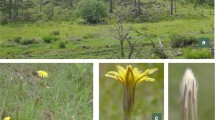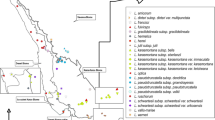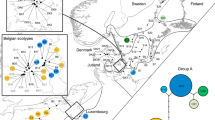Abstract
Muhlenbergia torreyi occurs in the southwestern United States, northern Mexico, and northwestern Argentina. Allozyme data were used to evaluate genetic diversity within and among populations of this amphitropical disjunct species. Electrophoretic examination of 22 putative enzyme loci in 15 populations revealed high levels of genetic variation (P ranging from 64.7 to 82.4;H from 0.527 to 0.757) and high levels of genetic diversity (F ranging from −0.584 to −0.939). All populations possess high levels of heterogeneity (F 1S approaching −1, mean of −0.837) and exhibit lower levels of genetic fixation among populations (F ST mean of 0.127). A comparison of genetic identity values among populations from North and South America indicates that the genetic variation is slightly greater (I=0.93) in North America than in South America (I=0.96). A total of 51 alleles were shared among all populations, and four unique alleles were detected: two from North American populations and two from South America. It seems likely thatMuhlenbergia torreyi has dispersed to South America recently, because the populations there are less variable. Chromosome numbers, not determined by the authors, of 2n=20, 21 forM. torreyi and 2n=80, 82 forM. arenicola are reported.Muhlenbegia arenicola is first reported from South America.
Resumen
Muhlenbergia torreyi habita en el suroeste de Estados Unidos, norte de México, y noreste de Argentina. Mediante el análisis de alozimas se evaluó la diversidad genética dentro y entre poblaciones de esta especie, que es disjunctiva anfitropical. El exámen electroforético de 22 loci putativos enzimáticos en 15 poblaciones, reveló altos niveles de variación genética (P varía de 64.7 a 82.4;H varía de 0.527 a 0.757) y altos niveles de diversidad genética (F varía de −0.584 a −0.939). Todas las poblaciones poseen altos niveles de heterogeneidad dentro de las mismas poblaciones (F IS cerca −1, media de −0.837) y exhiben bajos niveles de fijación genética entre poblaciones (F ST media de 0.127). Una comparación de valores de identidad genética entre poblaciones de Norte y Sudamérica indican que la variación genética es un poco mayor (I=0.93) en Norte América que en Sudamérica (I=0.96). Las poblaciones poseían un total de 51 alelos en común y se detectaron cuatro alelos únicos; dos en las poblaciones norteamericanas y dos en las poblaciones sudamericanas. Probablemente,Muhlenbergia torreyi ha sido dispersada recientemente hacia Sudamérica porque esta poblacion es menos variable. El número de cromosomas, no determinado por los autores, de 2n=20, 21 paraM. torreyi and 2n=80, 82 paraM. arenicola son reportados.Muhlenbergia arenicola es reportada por primera vez en Sudamérica.
Similar content being viewed by others
Literature Cited
Allred, K. 1981. Cousins to the south: amphitropical disjunctions in Southwestern grasses. Desert Pl. 3: 98–106.
Axelrod, D. I. 1985. Rise of the grassland biome, central North America. Bot. Rev. (Lancaster) 51: 163–201.
Beetle, A. A., J. A. Miranda Sánchez, V. Jarmillo Luque, A. M. Rodríguez Rodríguez, L. Aragón Melchor, M. A. Vergara Batilla, M. C. A. Chimal Hernández &O. Domínguez Sepúlveda 1995. Las Gramíneas de México, Tomo IV. Secretaría de Agricultura. Ganadería Y Desarrollo Rural, México.
Clayton, W. D. &S. A. Renvoize. 1986 Genera Graminum. Grasses of the world. Her Majesty’s Stationary Office, London.
Crawford, D. J., N. S. Lee &T. F. Stuessy. 1992. Plant species disjunctions: perspectives from molecular data. Aliso 13: 395–409.
Duvall, M. R., P. M. Peterson &A. H. Christensen. 1994. Alliances ofMuhlenbergia (Poaceae) within New World Eragrostideae are identified by phylogenetic analysis of mapped restriction sites from plastid DNAS. Amer. J. Bot. 81: 622–629.
Gottlieb, L. D. 1981. Electrophoretic evidence and plant populations. Progr. Phytochem. 7: 1–46.
— 1982. Conservation and duplication of isozymes in plants. Science 216: 373–380.
Hamrick, J. L. &M. J. W. Godt. 1989. Allozyme diversity in plant species. Pages 43–63.In: A. H. D. Brown et al., editors. Plant population geneties, breeding and genetic resources. Sinauer Associates, Sunderland, Massachusetts.
—,Y. B. Linhart &J. B. Minton. 1979. Relationships between life history characteristics and electrophoretically detectable genetic variation in plants. Ann. Rev. Ecol. Syst. 10: 173–200.
Hsu, J. 1983. Late Cretaceous and Cenozoic vegetation in China, emphasizing their connections with North America. Ann. Missouri Bot. Gard. 70: 490–508.
Jain, S. K. &P. L. Workman. 1967. Generalized Fstatistics and the theory of inbreeding and selection. Nature 214: 674–678.
Liston, A., L. H. Rieseberg &T. S. Elias. 1989. Morphological stasis and molecular divergence in the intercontinental disjunct genusDatisca (Datiscaceae). Aliso 12: 525–542.
Morden, C. W., J. Doebley &K. F. Schertz. 1987. A manual of techniques for starch gel electrophoresis ofSorghum isozymes. Texas Agric. Exp. Sta., MP-1635: 1–10, College Station.
Nei, M. 1972. Genetic distance between populations. Amer. Naturalist 106: 283–292.
— 1978. Molecular evolution genetics. Columbia University Press, New York.
Peterson, P. M. In press.In: M. E. Barkworth, K. M. Capels & L. A. Vorobik, editors. Manual of the grasses for the continental United States and Canada. U.S.D.A. Misc. Publ.
— &J. T. Columbus. 1997. Allelic variation in the amphitropical disjunctScleropogon brevifolius (Poaceae: Eragrostideae). BioLlania, Edición Especial 6: 473–490.
— &Y. Herrera A 1995. Allozyme variation in the amphitropical disjunctChaboissaea (Poaceae: Eragrostideae). Madroño 42: 427–449.
— &O. Morrone. 1998. Allelic variation in the amphitropical disiunctLycurus setosus (Poaceae: Muhlenbergiinae). Madroño 44: 334–346.
—,M. R. Duvall &A. H. Christensen. 1993. Allozyme differentiation amongBealia mexicana, Muhlenbergia argentea, andM. lucida (Poaceae: Eragrostideae). Madroño 40: 148–160.
—,R. D. Webster &J. Valdes-Reyna. 1995. Subtribal classification of the New World Eragrostideae (Poaceae: Chloridoideae). Sida 16: 529–544.
———. 1997. Genera of New World Eragrostideae (Poaceae: Chloridoideae). Smithsonian Contr. Bot. 87: 1–50.
Raven, P. H. &D. I. Axelrod. 1974. Angiosperm biogeography and past continental movements. Ann. Missouri Bot. Gard. 61: 539–673.
Swofford, D. L. &R. B. Selander. 1989.Biosys-1, a computer program for the analysis of allelic variation in population genetics and biochemical systematics. Release 1.7. University of Illinois, Urbana.
Sykes, G. R., A. H. Christensen &P. M. Peterson. 1997. A chloroplast DNA analysis ofChaboissaea (Poaceae: Eragrostideae). Syst. Bot. 22: 291–302.
Vogelmann, J. E. &G. J. Gastony. 1987. Electrophoretic enzyme analysis of North American and eastern Asian populations ofAgastache sect.Agastache (Labitate). Amer. J. Bot. 74: 385–393.
Weeden, N. F. &J. F. Wendel. 1989. Genetics of plant isozymes. Pages 46–72.In: D. E. Soltis & P. S. Soltis, editors. Isozymes in plant biology. Dioscorides Press, Portland, Oregon.
Wright, S. 1965. The interpretation of population structure by F-statistics with special regard to systems of mating. Evolution 19: 395–420.
— 1969. Evolution and genetics of populations. Vol. 2. The theory of gene frequencies. University of Chicago Press, Chicago.
— 1978. Evolution and genetics of populations. Vol. 4. Variability within and among natural populations. University of Chicago Press, Chicago.
Zuloaga, F. O., E. G. Nicora, Z. E. Rúgolo de Agrasar, O. Morrone, J. Pensiero &A. M. Cialdella. 1994. Catalogo de la familia Poaceae en la República Argentina. Monogr. Syst. Bot. Missouri Bot. Gard. 47: 1–178.
Author information
Authors and Affiliations
Rights and permissions
About this article
Cite this article
Peterson, P.M., Ortíz-Diaz, J.J. Allelic variation in the amphitropical disjunct Muhlenbergia torreyi (Poaceae: Muhlenbergiinae). Brittonia 50, 381–391 (1998). https://doi.org/10.2307/2807780
Issue Date:
DOI: https://doi.org/10.2307/2807780




